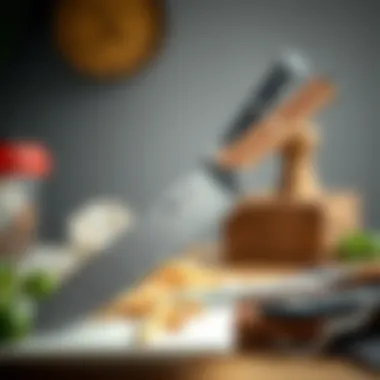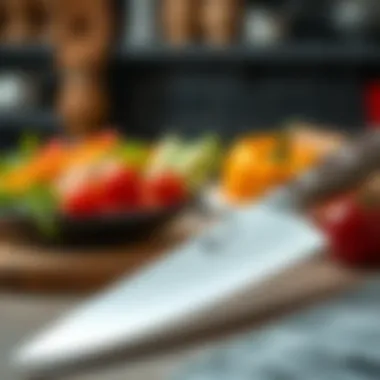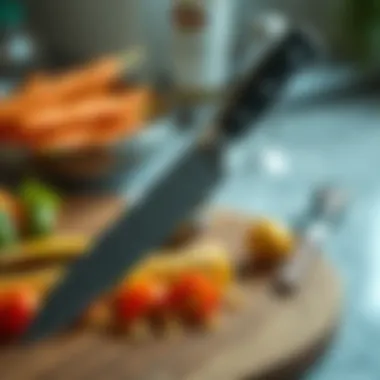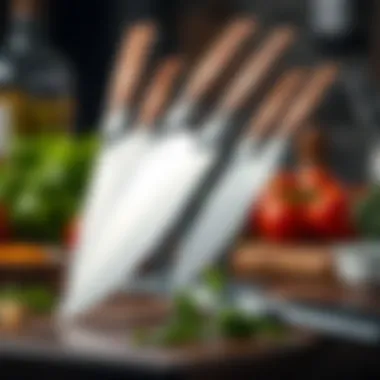Choosing the Best Kitchen Knife Sets Without Steak Knives


Intro
When stepping into the world of culinary arts, the tools you have at your disposal can make a world of difference. While many enthusiasts and chefs might gravitate towards complete knife sets that include every blade imaginable, this article takes a closer look at kitchen knife sets that purposefully exclude steak knives. This omission doesn't diminish the functionality; rather, it refocuses priorities on the essentials. Let's dive into what it means to equip your kitchen effectively with high-quality, versatile knives that cater to diverse cooking tasks.
The significance of a well-curated kitchen knife set cannot be overstated. From the humble home cook to the seasoned chef, the right knives razor-sharp blades can elevate your meal preparation, turning a tedious task into an enjoyable experience. But what should you be looking for in sets that don't include steak knives? By honing in on essential knife types and their roles, we can uncover a landscape of culinary possibilities that empowers your cooking adventures.
Understanding Kitchen Knife Sets
Choosing the right kitchen knife set is not merely about aesthetics or brand prestige. It’s about equipping yourself with the tools that will ultimately define your culinary experience. A well-thought-out knife set can transform your efficiency in the kitchen, allowing for safe and enjoyable food preparation.
Knife sets are designed with specific purposes in mind, catering to various kitchen activities. Understanding the composition and purpose of these sets helps you to select knives that fit your cooking style, whether you're an aspiring chef or a home cook who just enjoys dabbling in new recipes. The benefits extend beyond functionality; a good knife can inspire confidence in your cooking skills and improve your overall experience.
Definition and Purpose of Knife Sets
Knife sets typically include a selection of knives that serve different culinary roles. The fundamental purpose of a knife set is to provide an assortment of blades that facilitate various tasks—chopping, slicing, dicing, and more—thereby enhancing efficiency and safety in food preparation. For instance, trying to slice a crusty loaf of bread with a chef's knife is generally not the best option; a dedicated bread knife would offer a cleaner cut with less effort.
While steak knives are commonly included in sets, they are not essential for every cook. Many chefs often find that a well-rounded set of knives without steak knives can still meet all their culinary needs effectively.
Moreover, the convenience of having various knives readily available may save time and frustration in the kitchen. Rather than rummaging through drawers, a good set comes with a storage solution, ensuring that knives are organized and easily accessible.
Key Components of a Knife Set
When evaluating knife sets, understanding the key components is crucial. Here are some vital elements to consider:
- Chef's Knife: A multi-functional knife; perfect for vegetables, meats, and herbs.
- Paring Knife: Ideal for intricate tasks like peeling fruits and crafting garnishes.
- Utility Knife: A smaller, versatile knife that fills the gap between a chef’s knife and a paring knife.
- Santoku Knife: Often viewed as a fusion of Western and Eastern designs, it's useful for slicing, dicing, and mincing.
- Bread Knife: Equipped with serrated edges; perfect for cutting through crusty loaves without crushing them.
- Storage Block or Sheath: Protects the blades while keeping them organized, which is often overlooked in many discussions.
Types of Knives in Culinary Use
Understanding the types of knives used in culinary practices is essential for anyone intrigued by cooking. Each knife has its own purpose, crafted to optimize food preparation, ensuring tasks are done efficiently and effectively. From slicing and dicing to mincing and julienning, the right knife can significantly elevate the cooking experience.
Choosing the correct knife means considering what you intend to cook and how you prefer to prepare your ingredients. It’s not just about picking up any blade; it’s about matching the knife to the task at hand. With the right tools, even a novice can produce restaurant-quality results. Let’s dive deeper into the specific types of knives that every culinary enthusiast should know.
Chef's Knife: The Versatile Workhorse
The chef's knife is likely the most recognizable and essential tool in any kitchen. Its broad blade, typically ranging from 8 to 10 inches, makes it perfect for a wide range of tasks. Whether you’re chopping vegetables, slicing meat, or mincing herbs, this knife does it all.
What truly sets a chef's knife apart is its balance and the ability to rock back and forth while cutting. This rocking motion allows for efficient mincing and chopping. A well-made chef's knife feels like an extension of your hand, fitting comfortably and allowing for precise cuts without much effort.
"A good chef's knife is not just a tool; it's an ally in the kitchen."
Paring Knife: Precision at Its Finest


If the chef's knife is the workhorse, the paring knife is the finesse artist. With a much smaller blade, typically around 3 to 4 inches long, it is perfect for intricate tasks where precision is key. This includes peeling fruits, deveining shrimp, and making delicate incisions in meat.
Its design allows for a comfortable grip and control, which is crucial when handling small or detailed work. This knife is an indispensable companion when you need to focus on the finer aspects of food preparation, showcasing the skill and art in the kitchen.
Utility Knife: The All-Rounder
The utility knife is the unsung hero of knife sets. Often overlooked, it fills the gap between the chef's knife and the paring knife. With a blade length of around 5 to 6 inches, this knife is versatile enough for everyday tasks such as slicing sandwiches or cutting larger fruits and vegetables.
What makes it valuable is its adaptability. Need to carve out the core of an apple or slice through a piece of cooked meat? This knife can handle it all without requiring a complete set of specialized knives. Its general-purpose design makes it a helpful tool for both novice and experienced cooks.
Santoku Knife: A Japanese Influence
Originating from Japan, the Santoku knife has gained worldwide popularity, especially for its unique shape and functionality. The word "Santoku" translates to "three virtues," referring to its ability to slice, dice, and chop. Typically, its blade is shorter than a conventional chef's knife, measuring about 7 inches, and features a flatter edge.
The hollowed-out dimples on the blade help reduce friction and prevent food from sticking, which proves beneficial for efficient cutting. Whether you're preparing delicate sushi ingredients or tackling robust vegetables, the Santoku demonstrates precision and artistry.
Bread Knife: For Crusty Baked Goods
When it comes to slicing through crusty bread or cakes, a bread knife is a must-have. Its serrated edge is designed to grip the crust while gently sawing through the soft interior without squishing it. Typically longer than other knives, it allows bakers to manage loaves of all sizes with ease.
No one wants to ruin a beautifully baked masterpiece with a dull knife that crushes instead of slicing. A good bread knife ensures that every slice is clean and effortless.
In summary, understanding these fundamental knife types can workshop your cooking skills to new heights. Whether it’s the all-around utility knife or the specialized Santoku, having the right knives ensures that you’re armed for culinary success.
Material Considerations for Knife Sets
When embarking on the quest to select the perfect kitchen knife set, the materials used in their construction stand as a pivotal factor. Different materials not only influence the functionality of the knives but also affect how they perform over the long haul. Each material comes with its own set of pros and cons, which can significantly alter your culinary experience. Here, we take a closer look at the primary materials commonly found in knife sets, understanding their inherent characteristics and how they can align with your cooking needs.
Stainless Steel: Durability and Maintenance
Stainless steel has long been a beloved choice in the realm of kitchen knives. This material is known for its resilience. That’s mainly because it’s resistant to corrosion and staining. For the every day cook, it’s a solid pick. You don’t want to be fretting every time you're slicing a tomato or a juicy kiwi.
Moreover, stainless steel is quite forgiving when it comes to maintenance. Knives made from this alloy tend to need only a simple wash and dry after use. A quick hand wash with mild soap does wonders. Many consumers appreciate that this material holds its edge reasonably well without extensive sharpening sessions. However, if you're looking for superior sharpness straight out of the box, you might find that some higher grades of stainless steel provide a sharper edge more easily compared to others.
"The beauty of stainless steel is that it provides a balance between ease of use and reliable performance in the kitchen."
Carbon Steel: Sharpness and Edge Retention
Now, if sharpness is your priority, carbon steel is the heavyweight champion among kitchen knife materials. This material is revered for its ability to be honed to a sharp edge that outperforms most other alternatives. Once you give a carbon steel knife a good sharpening, it holds that edge like a dog with a bone.
However, it’s essential to keep in mind that carbon steel does come with a trade-off. It can and will rust if not properly maintained. For those who might be more on the casual side of cooking, that could mean needing to stay a bit more vigilant. Regular cleaning, drying after every use, and occasional oiling can keep your carbon steel knife looking pristine.


Yet for those who don't mind this extra care, the longevity and performance are simply unbeatable. Just remember, a well-cared-for carbon steel knife is an investment that pays dividends in the kitchen.
Ceramic Knives: Lightweight and Rust-Free
If you're searching for an alternative to traditional metal knives, ceramic knives might just tempt you. These are lightweight, making them easy to handle, perfect for long cutting sessions. With a very sharp edge, ceramic knives slice through food with grace. They also don’t require much maintenance since they don’t rust, making storage and care easier.
However, there's a catch. While ceramic knives are excellent for soft and semi-hard foods, they might not be the best option for tougher tasks. They can chip or break if mishandled, and sharpening them requires special tools. This makes them ideal for preparing fruits, vegetables, and boneless meats rather than chopping through bones or frozen foods.
When it comes down to it, understanding the different materials available in knife sets will help you make informed choices. Consider how often you cook, what types of food you prepare, and how much time you’re willing to dedicate to maintenance. Each material offers its own set of benefits, ultimately allowing you to craft a culinary experience that fits your lifestyle.
The Importance of Ergonomics
When it comes to kitchen knife sets, ergonomic design is not just a luxury; it's a necessity. Cookin' with knives that feel comfortable in your hand can elevate your experience and even improve your cooking performance. Whether you're chopping, slicing, or dicing, how a knife fits into your hand can mean the difference between a joyful culinary session and a painful ordeal.
The relationship between ergonomics and performance becomes evident when considering the lengthy periods of use involved in food preparation. A knife that promotes natural grip and posture can significantly reduce strain on the hand, wrist, and even the shoulder. On the flip side, ill-fitting or poorly designed handles can lead to discomfort, fatigue, and potentially long-term injury.
Moreover, balance is another crucial element. A well-balanced knife helps you cut more efficiently without exerting unnecessary force. Therefore, it’s not simply about the knife's aesthetic—comfort, control, and functionality must all be taken into account.
"Good ergonomics can prevent fatigue and improve precision, allowing home cooks to focus on creating delightful dishes rather than nursing aching hands."
Handle Design: Comfort and Control
Handles come in various shapes, materials, and sizes, yet not all are created equal. A handle designed with comfort in mind takes into account the natural contours of the human hand. Look for grips that are rounded yet firm enough to prevent slipping during use. Options like Santoku knives often have a D-shaped handle that allows for a secure grip without being overly restrictive.
The material used for the handle also plays a significant role. Wood, for instance, can offer warmth and a traditional feel, while rubber or synthetic materials may provide enhanced grip, especially when wet. The key is finding a handle that feels intuitive during use. Whether your hands are small or large, a well-designed handle can make cutting a breeze, letting you maintain better control over your knife.
Weight Distribution: Balancing Act
The weight of a knife isn’t uniformly experienced as many think; it’s all about weight distribution. A knife that feels top-heavy can be cumbersome and may lead to imprecise cutting. Conversely, a perfectly balanced knife allows for more finesse in your movements. This balance is often determined by the design of the blade in relation to the handle.
Many culinary experts recommend a knife that has the majority of its weight centered near the blade. This design lends itself to easier chopping motions and delightful self-guidance when cutting through tougher ingredients. When a knife feels balanced in your hand, control is significantly enhanced, giving you the confidence to tackle even the toughest cuts.
When selecting your kitchen knife set, it's prudent to consider these ergonomic factors. They can transform an everyday task into a seamless experience, marrying efficiency with comfort, making cooking a more enjoyable adventure.
Evaluating Knife Set Options
Choosing the right knife set amplifies your kitchen experience and can be a game changer for both seasoned chefs and budding cooks. It goes beyond just picking a few blades; it's about finding tools that resonate with your culinary style and meet your culinary challenges. Evaluating knife set options thoroughly can lead to more enjoyable cooking sessions and better results in your dishes. Here are some key elements and benefits to consider:
- Diversity of Knives: A well-rounded knife set should offer a variety of knives tailored for specific tasks. Look for sets that include essential types such as chef’s, paring, and utility knives. This varied arsenal enables different techniques, from mincing to slicing.
- Quality over Quantity: It's tempting to choose a knife set based solely on the number of items included. However, pay attention to the quality of each knife. A couple of high-quality knives generally outperform a larger collection of mediocre ones.
- Brand Reputation: Some brands carry a legacy in kitchenware, known for durability and performance. Researching user reviews and brand history can reveal valuable insights that steer you toward reputable options.
Recommended Knife Sets for Home Cooks


When delving into recommended knife sets, it's wise to consider the variety and quality that matches your cooking habits. Here are some noteworthy recommendations:
- Wüsthof Classic 7-Piece Knife Block Set: This set embodies precision, featuring high-carbon stainless steel blades known for edge retention. It's a splendid option for dedicated home chefs.
- Victorinox Swiss Army Cutlery 7-Piece Block Set: Offering excellent value, this set combines durability with a lightweight design. Great for everyday cooking, it’s a favorite among many home cooks.
- Global 2-Piece Knife Set: With a modern design and balanced handling, this set appeals to those who prefer a blend of art and functionality. The global brand is recognized for its sharpness and unique aesthetics.
As you explore these sets, ensure they fit your style and comfort. It's all about finding that perfect match that feels like an extension of your own hands.
Price Point and Value Assessment
When it comes to knife sets, understanding the price point and assessing value is crucial. A higher price tag doesn't always equate to better quality, and vice versa.
- Budget-Friendly Options: There are plenty of knife sets that don’t break the bank whilst still offering decent performance. Brands such as Mercer Culinary provide affordable sets that meet the needs of novices and casual cooks.
- Mid-Range Picks: For cooking enthusiasts who want reliability, mid-range sets from companies like Shun offer durability and advanced design without sky-high prices.
- Luxury Investments: If you view cooking as an art form, splurging on premium knife sets from makers like Miyabi or Henckels can be worth every penny. These knives often feature exquisite craftsmanship and elite materials, valuing serious chefs.
Caring for Your Knife Set
Caring for a kitchen knife set goes beyond just basic cleaning; it's a vital part of ensuring the longevity and performance of your knives. If you've invested in a quality knife set without steak knives, these tools are invaluable in the culinary world, and their upkeep can significantly enhance your cooking experience. A well-maintained knife will slice through anything from fresh vegetables to meats, improving both precision and efficiency in your kitchen tasks.
The benefits of proper care are twofold: not only does it extend the life of your knives, but it also maintains a sharper edge, which is crucial for safe and effective chopping, dicing, and slicing. When a knife is dull, it requires more force to cut through food, which can increase the risk of slips and accidents. Therefore, adopting a consistent care protocol is more than just routine; it’s essential for both safety and performance.
Cleaning and Maintenance Protocols
To keep your knife set in peak condition, implementing a thorough cleaning regimen is paramount. After each use, wash your knives by hand with warm, soapy water and a soft sponge. Avoid harsh abrasives or steel wool, as they can scratch and dull the blade material. Here are some specific pointers for effective cleaning and maintenance:
- Avoid the Dishwasher: Though it may seem quicker, the dishwasher’s environment can be brutal on your blades, leading to chipping and dulling.
- Dry Immediately: After washing, dry your knives right away! Leaving them wet can cause rusting, particularly with carbon steel blades, although stainless steel can also suffer from water spots.
- Store Correctly: Utilize a knife block, magnetic strip, or sheaths to store your knives safely. Avoid jumbled drawers, as this can lead to nicks and damage to the edges.
"A little care goes a long way; a clean knife is a safe knife."
Sharpening Techniques for Longevity
Sharpening your knives may feel daunting, but it's a crucial aspect of their care. A dull knife can be more dangerous than a sharp one, as the extra pressure can lead to slips and uneven cuts. Here are some techniques to keep your knives sharp and ready:
- Use a Honing Steel Regularly: This simple tool aligns the blade's edge, preserving sharpness between sharpening sessions. Regular honing (every 2-4 uses, depending on your cooking frequency) helps maintain the knife’s effectiveness.
- Sharpening Stones: Invest in a good quality whetstone. There are various grits available; a dual-grit stone typically works best, allowing you to establish a fine edge and then polish it effectively. Make sure to soak your stone in water before using it.
- Professional Sharpening Services: If you notice your knives aren’t performing as they should despite your efforts, consider reaching out to a professional. They often use specialized tools and techniques that can rejuvenate even the most tired blades.
Regularly sharpening and maintaining your knives is an investment in not just the tools themselves but in the overall quality of your culinary creations. By adding a bit of care into your routine, you ensure that your kitchen remains a place of joy and efficiency.
Closure: Selecting the Right Kitchen Knife Set
Choosing the right kitchen knife set can feel like finding a needle in a haystack. The countless options can easily overwhelm even the most seasoned home chef. This article has laid out a roadmap for understanding what constitutes a high-quality knife set, minus the steak knives. The essence of kitchen knives extends beyond mere blades; they embody the craftsmanship required to elevate mundane ingredients into culinary masterpieces.
When selecting a knife set, it's crucial to weigh several key elements, including the types of knives available, their materials, ergonomic considerations, and your personal cooking style. Having the right tools in your arsenal isn’t just about convenience; it directly contributes to the quality of the cooking process itself. For instance, using a sharp chef’s knife instead of a dull one can drastically alter the texture and flavor of your ingredients, enabling you to execute dishes with finesse.
As you distill the information learned from the previous sections, consider how different knives serve varied purposes. Each type—whether it be the robustness of a chef’s knife or the precision of a paring knife—offers unique benefits that align with particular tasks in your culinary repertoire. Furthermore, investing time into understanding materials like stainless or carbon steel will pay off in the long run. Harder steel can keep an edge longer, which means your knives will serve you better day in and day out.
Don’t overlook ergonomics, too. It’s not just about how the knife looks; it’s about how it feels in your hand. A comfortable grip can greatly minimize fatigue during long cooking sessions, making your experience an enjoyable one instead of a chore. Select knives that feel natural to you; the right weight and balance can enhance your precision and confidence.
Finally, remember that aligning your knife selection with your culinary style is paramount. A baker may prioritize a good serrated knife while someone focused on Asian cuisines might lean towards a Santoku. This alignment ensures that each tool not only meets your needs but also reflects your cooking philosophy.
"The right knife can change the way you cook. It's the bridge between intention and execution."







